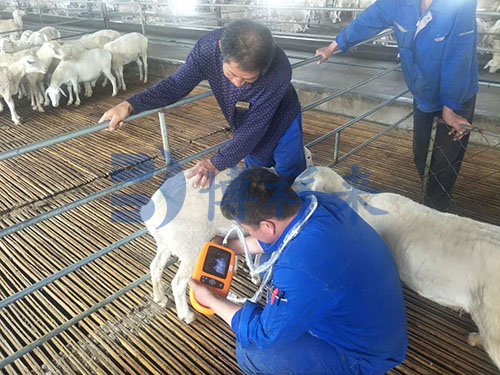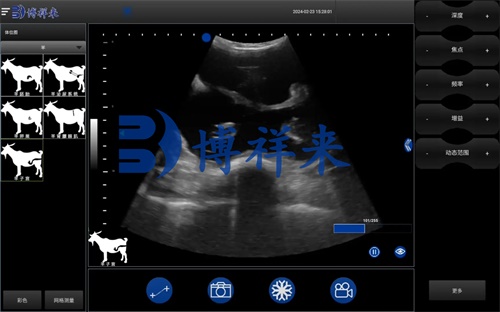As a sheep farmer managing a large-scale livestock operation, I’ve come to rely increasingly on technology to improve animal health and optimize productivity. One of the most transformative tools in our arsenal has been ultrasonography, especially for early weaning management of lambs. Early weaning—commonly defined as weaning at 30–45 days rather than the traditional 60–90 days—offers several economic and management advantages, but also introduces challenges that demand precision, especially in health monitoring. This is where ultrasound plays a key role.

In diesem Artikel, I will share how ultrasonography, when used properly, helps us make more informed decisions, monitor physiological changes in ewes and lambs, and ultimately reduce weaning-related complications. My aim is to provide fellow livestock producers and veterinarians with a practical yet professional guide rooted in experience and scientific principles.
Understanding Ultrasonography in Livestock Practice
Ultrasonography is a non-invasive diagnostic technique that uses high-frequency sound waves—typically in the 2–18 MHz range—to create real-time images of internal body structures. The sound waves are emitted from a transducer, which is placed against the animal’s body using a coupling gel. Echoes generated as the sound beam passes through various tissues are captured by the same transducer and transformed into grayscale images, most commonly displayed in B-mode (brightness mode).
For farm applications, ultrasound is predominantly used to assess Weichteile, including internal organs and reproductive structures. In sheep, it is most commonly employed for pregnancy diagnosis, but its utility in early weaning strategies is often underestimated.
Why Early Weaning Matters in Sheep Farming
Early weaning is practiced to:
-
Improve ewe reproductive efficiency by enabling earlier rebreeding
-
Enhance feed conversion ratios in lambs by initiating concentrated feeding earlier
-
Prevent parasite transmission and reduce mastitis in ewes
Aber, without close physiological monitoring, early weaning can lead to nutritional deficits, poor growth, immune suppression, and increased mortality in lambs. That’s why real-time ultrasound monitoring of both ewes and lambs plays a pivotal role in executing this strategy effectively.

Ultrasonography for Monitoring Ewe Recovery and Uterine Health
One of the first places we use ultrasound post-lambing is in assessing uterine involution in ewes. After parturition, the uterus must return to its normal size and condition before the ewe can be rebred. Through transabdominal scanning, we can evaluate:
-
The size and shape of the uterus
-
Presence of retained fetal membranes or uterine fluid
-
Any abnormal tissue structures indicating infection
By ensuring that ewes are recovering normally, we can plan for their next breeding cycle more confidently, even while their lambs are still in the early weaning phase.
Assessing Lamb Development with Ultrasound
For the lambs, ultrasound offers a non-invasive way to monitor growth parameters, particularly:
-
Body fat reserves through subcutaneous fat measurement
-
Rumen development, which is vital before transitioning completely to solid feed
-
Organ development, particularly liver and kidneys, to evaluate metabolic adaptation
We typically perform scans at around 21 Tage, just before the early weaning process begins. The information helps us decide whether a lamb is physiologically ready to switch from milk to starter feeds and forage.
Zum Beispiel, a lamb with poor fat reserves or an underdeveloped rumen might be held back and weaned later. This approach reduces the risk of post-weaning growth slumps and mortality.

Using Ultrasound to Identify and Prevent Health Risks
Ultrasound is also useful in early disease detection, especially during the critical transition period. Some conditions we can catch early include:
-
Pneumonia, detectable through thoracic scans showing lung consolidations
-
Abomasal bloat, recognizable through abnormal stomach dilation patterns
-
Joint and muscle disorders, which can affect suckling and mobility
By catching these problems early, we can intervene with treatment or isolate the affected lambs, minimizing the risk of group infections or welfare issues.
Reproductive Planning in the Ewes Post-Weaning
Ultrasound is also instrumental in tracking follicular activity and ovarian status in ewes after lambs are weaned. Transrectal scanning enables us to determine if the ewe is cycling again and ready for mating. With this insight, we can time artificial insemination or natural mating more effectively, reducing open days and increasing annual lambing rates.
The Economic Value of Ultrasound in Early Weaning Systems
From my personal experience, the cost of implementing ultrasound diagnostics is easily offset by gains in:
-
Reduced lamb mortality
-
Faster lamb weight gains and earlier market readiness
-
Shortened ewe interlambing intervals
-
Decreased veterinary costs from early disease interventions
Over time, the return on investment becomes substantial. Zusätzlich, das data-driven approach enabled by ultrasound supports better record-keeping and decision-making, which is critical for larger flocks.

Equipment and Skill Requirements
Implementing ultrasound on the farm requires:
-
Ein Tragbar Ultraschall für Veterinärmedizin machine with transducers suited for small ruminants
-
Operator training to identify normal and pathological findings accurately
-
Proper animal handling facilities to ensure stress-free scanning
We initially relied on veterinary technicians, but now, after hands-on training and experience, I and a few of my staff handle basic scanning tasks ourselves.
Challenges and Considerations
Despite its advantages, ultrasonography has limitations. These include:
-
Reduced accuracy in animals with excessive fleece or body fat
-
Dependency on operator skill for image interpretation
-
Limited depth penetration with high-frequency probes
Nonetheless, regular practice and targeted use have helped us mitigate most of these issues. Combining ultrasound results with other clinical signs and growth records ensures well-rounded decisions.
Schlussfolgerung
Ultrasound has revolutionized how we manage early weaning in lambs on our farm. From monitoring ewe recovery and lamb development to preventing disease and planning reproductive cycles, this technology provides us with real-time insights that are both practical and actionable.
In the context of early weaning, ultrasonography is not just a diagnostic tool—it’s a management partner. By incorporating it into our routine protocols, we’ve improved not just animal welfare but also the economic viability of our operation. I strongly recommend other livestock producers consider adding ultrasound to their early weaning toolkit.
References
-
González-Bulnes A, et al. (2010). Ultrasonographic assessment of fetal development in small ruminants. Reproduction in Domestic Animals.
-
Dwyer CM. (2008). The welfare of the neonatal lamb. Small Ruminant Research.
-
Szenci O. (2021). Ultrasonography in sheep reproduction and health management. Veterinary Clinics of North America: Food Animal Practice.